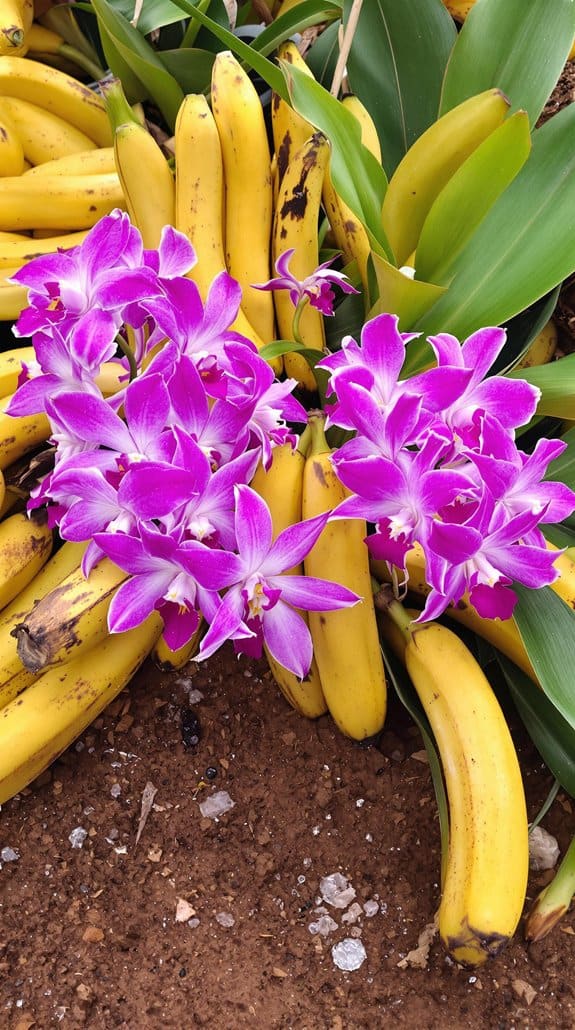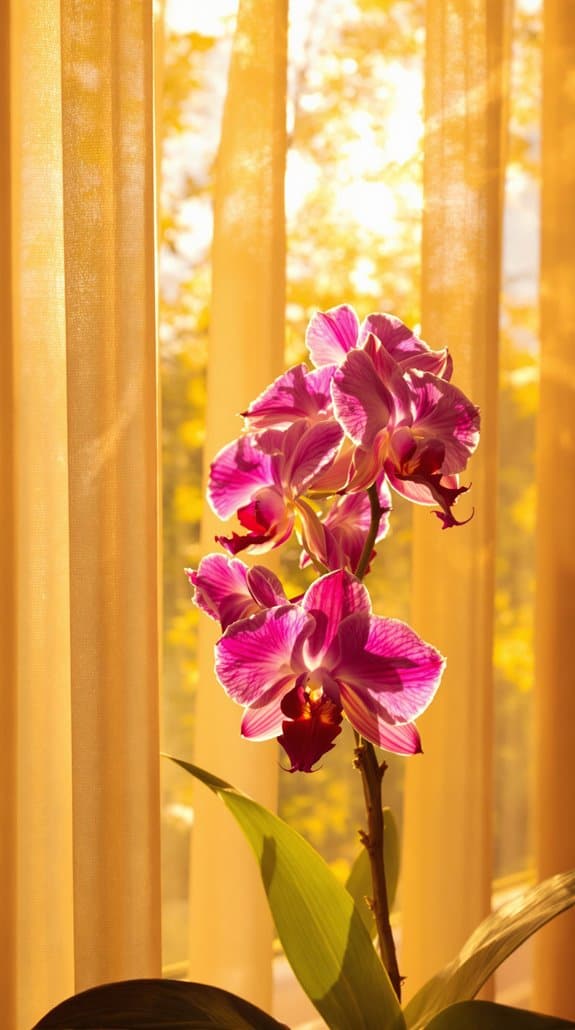7 Secret Orchid Tricks That Will Blow Your Mind
I've discovered seven mind-blowing orchid tricks that'll transform your growing game. By watering with ice cubes, you'll provide steady moisture without overwatering. Used coffee grounds boost nitrogen levels, while banana peel "tea" delivers natural nutrients your orchids crave. Creating a humidity chamber through double potting protects sensitive roots, and strategic light timing mimics natural cycles for ideal blooming. I've even found that a simple bathroom setup can create the perfect growing environment. These unconventional but effective methods have revolutionized how I care for my orchids, and there's so much more to these fascinating techniques.
Contents
- 1 The Ice Cube Watering Method
- 2 Coffee Grounds for Stunning Blooms
- 3 Double Potting Magic
- 4 Banana Peel Fertilizer Secret
- 5 Natural Humidity Cabinet Hack
- 6 Strategic Bathroom Growing
- 7 Light Therapy Timing
- 8 Frequently Asked Questions
- 8.1 Can Orchids Survive a Power Outage During Winter Months?
- 8.2 Why Do Some Orchid Flowers Turn Green Instead of Wilting?
- 8.3 Is Playing Music Beneficial for Orchid Growth and Blooming?
- 8.4 How Do Wild Orchids Cope With Extreme Temperature Changes?
- 8.5 Can Orchids Recognize and Respond to Their Primary Caregiver?
The Ice Cube Watering Method

While caring for orchids can seem formidable, I've found that the ice cube watering method makes it surprisingly simple. I place 2-3 ice cubes on the orchid's potting medium once a week, allowing them to melt slowly and provide consistent moisture without overwatering.
This method prevents the common mistake of drowning orchids with too much water at once. As the ice melts gradually, it gives the roots time to absorb moisture while reducing the risk of root rot. I've noticed that this technique works especially well for Phalaenopsis orchids grown indoors.
I place the ice cubes away from the plant's crown and leaves, positioning them instead near the edge of the pot. This guarantees the cold won't damage the sensitive plant tissues while still delivering the water where it's needed most.
Coffee Grounds for Stunning Blooms

Coffee grounds offer a surprising boost for orchid health when used sparingly in the growing medium. I've found that mixing one tablespoon of used coffee grounds into the top layer of bark every two months provides essential nitrogen and slightly increases acidity, which orchids love.
I recommend using only dried grounds to prevent mold growth, and I always guarantee they're scattered lightly rather than clumped. When I'm repotting my orchids, I mix a small amount into the fresh medium, keeping the ratio at about 10% coffee grounds to 90% bark mix.
Don't overdo it – too much can burn the roots or create overly acidic conditions. I've noticed my orchids respond best when I use this technique alongside proper light and watering schedules, resulting in more vibrant blooms.
Double Potting Magic

Double potting regularly saves my orchids from common growing mistakes while creating ideal moisture conditions. I place my orchid's plastic growing container inside a slightly larger decorative pot, ensuring there's a small gap between the two. This space acts as a humidity chamber, providing consistent moisture levels that orchids crave.
I've found that double potting also protects roots from temperature fluctuations and makes it easier to monitor water needs. When I water, I simply lift the inner pot to check if it's light (needs water) or heavy (still moist). The outer pot catches excess water, preventing root rot while maintaining humidity. Plus, I can easily switch decorative pots to match my decor without disturbing the orchid's delicate root system.
Banana Peel Fertilizer Secret

Banana peels hold a potent secret for orchid fertilization that I've used successfully for years. The peels contain essential nutrients like potassium, phosphorus, and calcium that orchids crave. I'll show you my proven method to harness this power.
First, I dry several banana peels completely, then grind them into a fine powder using a coffee grinder. I mix one tablespoon of this powder with a quart of water, letting it steep overnight. When applying, I dilute this concentrated mixture using one part banana tea to four parts water.
I fertilize my orchids with this solution every two weeks during the growing season, reducing to monthly applications during winter dormancy. Since implementing this natural approach, I've noticed stronger blooms, greener leaves, and more robust root systems.
Natural Humidity Cabinet Hack

Moisture is the key to thriving orchids, and I've discovered a simple DIY humidity cabinet that doesn't require expensive equipment. I take a clear plastic storage bin, flip it upside down, and place it over my orchids on a waterproof tray filled with pebbles and water.
I've cut small ventilation holes in the sides to prevent mold growth while maintaining humidity. The water gradually evaporates from the pebble tray, creating a perfect microclimate that mimics an orchid's natural habitat. I keep the water level just below the pebbles' surface, ensuring the pots don't sit in water.
This setup maintains 60-80% humidity levels consistently. I check the water level every few days and adjust the ventilation holes' size depending on my home's ambient humidity.
Strategic Bathroom Growing

The natural humidity of a bathroom makes it an ideal growing spot for orchids, especially if you have limited space. I recommend placing your orchids near a window that receives indirect sunlight, as direct sun through bathroom windows can scorch the leaves. If your bathroom lacks natural light, I've found that installing a small LED grow light works wonders.
I position my orchids away from toilets to prevent bacterial spread and place them on shower windowsills or vanity counters where they can catch rising steam. When I shower, I leave the door closed to trap humidity, creating a mini greenhouse effect. Just guarantee proper air circulation by running a small fan or opening the window for 15-20 minutes daily to prevent mold growth on leaves or roots.
Light Therapy Timing

Managing orchid exposure to artificial grow lights requires careful timing to mimic natural daylight cycles. I've found that most orchids thrive with 12-14 hours of light during their growing season, followed by 10-12 hours of complete darkness. I set my timer to turn on at 6 AM and off at 8 PM.
During winter months, I'll extend the light exposure to 14-16 hours to compensate for shorter natural days. I've noticed that Phalaenopsis orchids respond particularly well to this schedule. When I see reddish tints on leaves, that's my signal to reduce exposure time or move the plant farther from the light source. I always adjust gradually – changing timing by 30 minutes per week – to prevent shock to my orchids' systems.
Frequently Asked Questions
Can Orchids Survive a Power Outage During Winter Months?
I'll help you protect your orchids during winter power outages. Yes, they can survive, but you'll need to act quickly. I recommend moving them away from cold windows and grouping them together to create a warmer microclimate. I wrap my orchids in newspaper or bubble wrap for insulation. During daylight, place them near the brightest window, but move them back at night to avoid cold drafts.
Why Do Some Orchid Flowers Turn Green Instead of Wilting?
Like a chameleon changing its colors, orchid blooms can sometimes turn green instead of gracefully fading away. I'll tell you why: this happens when your orchid is trying to save energy. What you're seeing is chlorophyll returning to the petals, as the plant attempts to photosynthesize through its flowers. It's actually a survival mechanism I've noticed in stressed orchids, especially when they're fighting to maintain energy reserves.
Is Playing Music Beneficial for Orchid Growth and Blooming?
While I'd love to tell you that playing music will make your orchids bloom better, there's no conclusive scientific evidence supporting this claim. Plants do respond to vibrations, but studies haven't proven that music specifically benefits orchid growth or flowering. If you enjoy playing music around your plants, go ahead – it won't hurt them! Just remember that proper light, water, and fertilizer are what truly matter for orchid success.
How Do Wild Orchids Cope With Extreme Temperature Changes?
Let me share how these resilient beauties handle nature's mood swings. Wild orchids have developed clever adaptations to cope with temperature extremes. I've observed how they'll store water in their pseudobulbs and roots during harsh times, while their thick leaves help insulate against both hot and cold. They'll also seek sheltered spots beneath tree canopies, where I've noticed they create their own microclimate. It's amazing how they've mastered survival!
Can Orchids Recognize and Respond to Their Primary Caregiver?
While orchids don't "recognize" people in the way pets do, I can tell you that they do respond to consistent care patterns. I've noticed that orchids adapt to regular watering schedules and light exposure that you establish. They'll grow toward their light source and develop roots in response to moisture patterns. However, these responses are purely based on environmental cues rather than any emotional or cognitive recognition of their caregiver.
